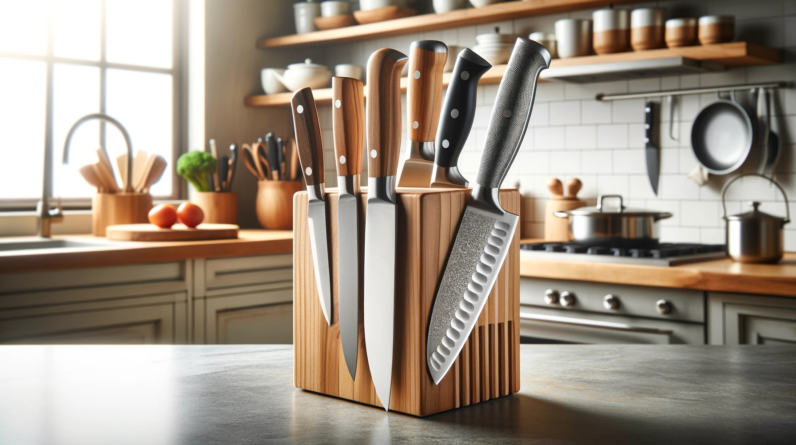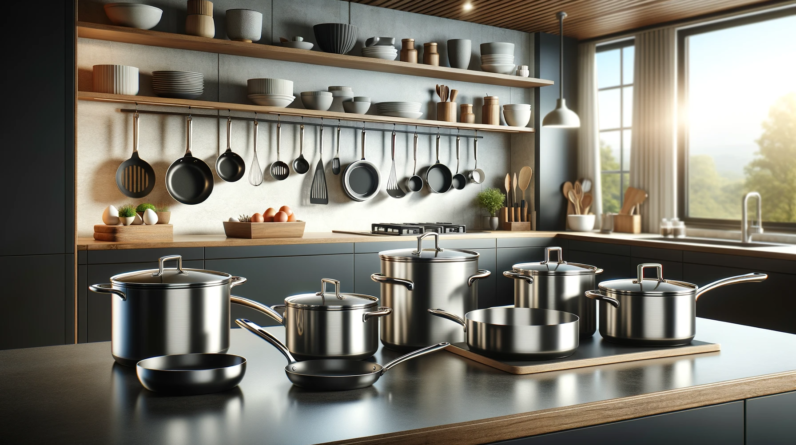
Disclaimer: This post may contain affiliate links. As an Amazon Associate, we earn from qualifying purchases.
Imagine stepping into a chef’s kitchen, where mouthwatering aromas float through the air and the sounds of sizzling pans fill the room. As you observe the flurry of activity, you can’t help but wonder, what are the three most commonly used knives in this culinary paradise?
Wonder no more, for we are about to uncover the essential blades that no chef can do without. From slicing and dicing to chopping and mincing, these versatile tools are the backbone of every chef’s arsenal. So, keep reading to discover the exceptional knives that bring culinary creations to life in the fast-paced world of a chef’s kitchen.
Chef’s Knife
 The chef’s knife is the most essential tool in any chef’s kitchen. It has a versatile design that makes it suitable for a wide range of tasks. The blade of a chef’s knife is usually around 8 to 10 inches long and features a slight curve, allowing for a rocking motion when cutting. This curved shape makes it easier to chop and mince ingredients quickly and efficiently.
The chef’s knife is the most essential tool in any chef’s kitchen. It has a versatile design that makes it suitable for a wide range of tasks. The blade of a chef’s knife is usually around 8 to 10 inches long and features a slight curve, allowing for a rocking motion when cutting. This curved shape makes it easier to chop and mince ingredients quickly and efficiently.
The blade of a chef’s knife is typically made of high-quality stainless steel, which ensures durability and resistance to corrosion. The sharp edge of the blade makes it ideal for precise slicing and dicing.
Additionally, some chef’s knives have a granton edge, which consists of small indentations along the blade. These indentations help to prevent food from sticking to the blade while cutting, reducing friction and improving efficiency.
The handle of a chef’s knife is usually made of wood, plastic, or composite materials. The handle should have an ergonomic design, providing a comfortable and secure grip. A well-designed handle allows for excellent control and precision while cutting, reducing the risk of accidents or injuries.
The uses of a chef’s knife are extensive. It can be used for chopping vegetables, slicing meat, mincing herbs, and even crushing garlic. With its versatility, a chef’s knife is the go-to tool for most kitchen tasks.
Whether you are a professional chef or a home cook, having a high-quality chef’s knife is essential for creating delicious meals with ease and efficiency.
Paring Knife
 The paring knife is a small, versatile knife that comes in handy for delicate tasks that require precision. It usually has a blade length of 3 to 4 inches, making it suitable for intricate cutting and peeling. The long, narrow blade allows for intricate work, such as deveining shrimp or removing seeds from fruits and vegetables.
The paring knife is a small, versatile knife that comes in handy for delicate tasks that require precision. It usually has a blade length of 3 to 4 inches, making it suitable for intricate cutting and peeling. The long, narrow blade allows for intricate work, such as deveining shrimp or removing seeds from fruits and vegetables.
The blade of a paring knife is thin and sharp, allowing for precise control and accuracy. It is typically made of stainless steel, ensuring durability and resistance to rust. The handle of a paring knife is usually small and lightweight, providing ease of maneuverability.
The uses of a paring knife are vast. It is perfect for tasks such as peeling fruits and vegetables, removing the eyes from potatoes, or creating decorative garnishes. It is an indispensable tool for any chef or cook who values attention to detail and wants to elevate their food presentation.
Utility Knife
 The utility knife is a versatile tool that bridges the gap between the chef’s knife and the paring knife. It usually has a blade length of around 4 to 6 inches, making it slightly larger than a paring knife but smaller than a chef’s knife. Its size and design make it suitable for a wide range of cutting tasks.
The utility knife is a versatile tool that bridges the gap between the chef’s knife and the paring knife. It usually has a blade length of around 4 to 6 inches, making it slightly larger than a paring knife but smaller than a chef’s knife. Its size and design make it suitable for a wide range of cutting tasks.
The blade of a utility knife is usually straight and has a pointed tip, allowing for precise cutting. It is made of stainless steel, ensuring durability and longevity. The handle of a utility knife is similar to that of a chef’s knife, providing a comfortable and secure grip.
The uses of a utility knife are diverse. It can be used for slicing sandwiches, cutting through small bones or joints, and trimming fat from meat. It is also handy for tasks that require more control than a chef’s knife, such as slicing tomatoes or trimming green beans.
A utility knife is a great addition to any kitchen as it offers versatility and convenience for various cutting tasks.
Santoku Knife
 The Santoku knife, originating from Japan, has gained popularity in Western kitchens due to its unique design and functionality. It typically has a blade length of around 6 to 7 inches. The word “Santoku” translates to “three virtues” in Japanese, referring to its versatility in slicing, dicing, and mincing.
The Santoku knife, originating from Japan, has gained popularity in Western kitchens due to its unique design and functionality. It typically has a blade length of around 6 to 7 inches. The word “Santoku” translates to “three virtues” in Japanese, referring to its versatility in slicing, dicing, and mincing.
The blade of a Santoku knife is wide and flat, featuring a slight curve at the edge. This design allows for efficient chopping and slicing with a simple up-and-down motion. The blade is made of high-quality stainless steel, ensuring sharpness and durability.
The handle of a Santoku knife is usually shorter and lighter than that of a chef’s knife, providing excellent control and maneuverability.
It is designed to offer a comfortable and secure grip, reducing the risk of accidents or fatigue during prolonged use.
The uses of a Santoku knife are similar to that of a chef’s knife. It is perfect for slicing, dicing, and mincing vegetables, fish, and meat. Its versatility and ease of use make it a popular choice for both professional chefs and home cooks looking to add a touch of Japanese precision to their kitchen.
Bread Knife
 A bread knife is an essential tool for anyone who loves freshly baked bread. Its long, serrated blade allows for smooth and effortless slicing through crusty bread, without crushing or tearing the delicate interior.
A bread knife is an essential tool for anyone who loves freshly baked bread. Its long, serrated blade allows for smooth and effortless slicing through crusty bread, without crushing or tearing the delicate interior.
The blade of a bread knife is usually around 8 to 10 inches long, featuring a row of sharp serrations along one edge. These serrations grip the bread’s crust while cutting, ensuring clean, even slices. The blade is made of stainless steel, providing durability and resistance to corrosion.
The handle of a bread knife is typically longer and wider than other knives, offering a comfortable grip and better leverage. It is designed to withstand the pressure required to slice through thick or dense bread without straining the hand or wrist.
The primary use of a bread knife is, of course, slicing bread. From baguettes to sourdough loaves, this knife ensures you can enjoy a perfect slice every time, preserving the bread’s texture and crumb. It can also be used for slicing cakes with delicate layers or meringue-topped desserts without compromising their presentation.
Boning Knife
 A boning knife is a specialized tool designed for precisely removing bones from meat, poultry, and fish. It has a thin, flexible blade that allows you to navigate around bones and joints with ease.
A boning knife is a specialized tool designed for precisely removing bones from meat, poultry, and fish. It has a thin, flexible blade that allows you to navigate around bones and joints with ease.
The blade of a boning knife is typically around 5 to 6 inches long and has a pointed tip. It is made of high-quality stainless steel, ensuring sharpness and resistance to rust. The thin, flexible blade allows for precise maneuverability, minimizing the risk of wastage or damage to the meat.
The handle of a boning knife is usually straight, offering a comfortable and secure grip.
It may have a slight texture or ergonomic design to enhance control during delicate boning tasks.
The primary use of a boning knife is, as the name suggests, removing bones from meat or fish. It is exceptionally efficient for removing ribs, filleting fish, or deboning poultry. With its precision and flexibility, a boning knife is a valuable tool for any chef or home cook who frequently works with raw meat or fish.
Carving Knife
 A carving knife is a long, slender knife used primarily for slicing cooked meats, such as roasts, hams, or turkeys. Its long, narrow blade ensures smooth, even slices without tearing or shredding the meat.
A carving knife is a long, slender knife used primarily for slicing cooked meats, such as roasts, hams, or turkeys. Its long, narrow blade ensures smooth, even slices without tearing or shredding the meat.
The blade of a carving knife is usually around 8 to 12 inches long and features a sharp, pointed tip. It is made of stainless steel, ensuring sharpness and durability even when used for extended periods.
The handle of a carving knife is usually longer and wider than other knives, providing a comfortable and secure grip. It is designed to offer excellent control and leverage for precise slicing.
The primary use of a carving knife is to slice cooked meats. Its long, thin blade minimizes the need for excessive pressure, allowing for clean and even slices. A carving knife is a perfect tool for special occasions or family gatherings when you want to present beautifully sliced meat to your guests.
Fillet Knife
 A fillet knife is another specialized tool designed for precise and delicate tasks, particularly when working with fish.
A fillet knife is another specialized tool designed for precise and delicate tasks, particularly when working with fish.
Its thin, flexible blade allows for effortless maneuverability around bones and skin.
The blade of a fillet knife is typically around 6 to 9 inches long and has a pointed tip.
It is made of high-quality stainless steel, ensuring sharpness and resistance to corrosion.
The thin, flexible blade allows for delicate and precise cuts, minimizing wastage or damage to the fish.
The handle of a fillet knife is usually straight, offering a comfortable grip. It may have a textured surface or ergonomic design to enhance control during intricate filleting tasks.
The primary use of a fillet knife is, as the name suggests, filleting fish. Its sharp, flexible blade allows for precise cuts along the fish’s bones, ensuring clean and boneless fillets. A fillet knife is an indispensable tool for anyone who frequently cooks fish and wants to achieve professional-level results.
Cleaver
 A cleaver is a heavy, sturdy knife widely used in Asian cuisine for chopping through bones and tough ingredients. Its thick, rectangular blade provides excellent leverage and power for heavy-duty cutting tasks.
A cleaver is a heavy, sturdy knife widely used in Asian cuisine for chopping through bones and tough ingredients. Its thick, rectangular blade provides excellent leverage and power for heavy-duty cutting tasks.
The blade of a cleaver is usually around 6 to 8 inches long and features a broad, flat shape. It is made of high-quality stainless steel, ensuring durability and resistance to corrosion. The thick spine of the blade allows for forceful chopping without the risk of bending or breaking.
The handle of a cleaver is typically made of wood or composite materials, offering a solid grip. It is designed to withstand the pressure applied during heavy chopping tasks, providing comfort and control.
The uses of a cleaver are diverse. Apart from chopping through bones, a cleaver is also handy for breaking down large cuts of meat, such as beef or pork, into smaller pieces.
It can also be used for smashing garlic cloves, crushing ginger, or even tenderizing meat by using the flat side of the blade. A cleaver is an essential tool in any kitchen that requires heavy-duty cutting and chopping.
Tomato Knife
 A tomato knife is a small, serrated knife specifically designed for slicing through delicate fruits and vegetables, such as tomatoes or citrus fruits, without squashing or tearing the flesh.
A tomato knife is a small, serrated knife specifically designed for slicing through delicate fruits and vegetables, such as tomatoes or citrus fruits, without squashing or tearing the flesh.
The blade of a tomato knife is usually around 4 to 5 inches long and features sharp serrations along one edge. These serrations grip the skin of the fruit or vegetable while cutting, ensuring clean, smooth slices. The blade is made of stainless steel, providing durability and resistance to rust.
The handle of a tomato knife is typically small and lightweight, offering excellent control and maneuverability.
It is designed to provide a comfortable and secure grip, reducing the risk of accidents or fatigue.
The primary use of a tomato knife is slicing tomatoes, cucumbers, or other delicate fruits and vegetables with ease. Its serrated edge ensures clean cuts without crushing the flesh or releasing excess juice. A tomato knife is a valuable tool in any kitchen where precision slicing and presentation are valued.
In conclusion, a well-stocked kitchen should include a variety of knives to tackle different cutting tasks effectively. The chef’s knife, paring knife, and utility knife are the three most commonly used knives in a chef’s kitchen. Each knife has its unique design, blade, handle, and uses, making it essential for specific tasks.
By understanding the characteristics and uses of these knives, you can elevate your cooking skills and create delicious meals with ease. So why not invest in high-quality knives and equip yourself with the right tools for culinary success? Happy cooking!





